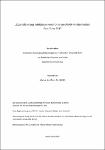Quantifizierung infektiöser rekombinanter AAV9-Partikel mittels Real-Time PCR
Best, Johanna
Saisonelle Grippewellen, ausgelöst durch den hoch adaptiven Influenzavirus, stellen die medizinische Versorgung jährlich vor eine große Herausforderung. Die schnelle und einfache Übertragung der Viren und ihre oft hohe Infektiosität führt zu einem großen Anteil an Influenza-assoziierten Krankschreibungen und Todesfällen. Dadurch entstehen erhebliche Kosten in der Wirtschaft und Krankenversorgung. Derzeitige Impfstoffe können keinen universellen Schutz vor einer Infektion garantieren und müssen jährlich an die neu zirkulierenden Viren angepasst werden. Die stetige Veränderung der Viren durch Antigen-shift/drift birgt ein enormes Potential einer Pandemie. Um unter anderem Risikogruppen besser vor einer Infektion zu schützen und die Gefahr einer Pandemie zu verringern, wird an universellen Influenzaimpfstoffen geforscht. Ein Ansatz für die Herstellung eines universellen Influenzaimpfstoffes ist es, das hoch konservierte Nukleoprotein über einen AAV-Shuttlevektor dem Immunsystem stabil zu präsentieren. In dem hier verwendeten Impfmodell wird das Nukleoprotein in den apathogenen Adeno-assozieerten Virus 9 kloniert. Die generierten Partikel werden einem Probanden injiziert. In Folge der Infektion baut der Proband eine T-Zell Immunantwort gegen das Nukleoprotein auf. So wäre er gegen diverse Subtypen der Influenza A-Viren geschützt. Um die Qualität des Impfstoffes bezüglich der Infektiosität der rAAV-Partikel zu überprüfen, wurde in dieser Arbeit eine Möglichkeit untersucht, die infektiösen Partikel mittels einer Real-Time PCR zu quantifizieren. Für die Bestimmung der infektiösen Partikel in einer Viruspräparation, wurde sich die Eigenschaft der Viren zu Nutze gemacht, dass ihr Genom nach der erfolgreichen Infektion einer Zelle doppelsträngig vorliegt. DNA-Moleküle nicht infektiöser Viren liegen weiterhin einzelsträngig vor. Mittels eines S1-Verdaus werden die einzelsträngigen DNA-Abschnitte verdaut. In der qPCR werden dann nur die doppelsträngigen DNA-Moleküle der infektiösen Viren quantifiziert. Die Rahmenbedingungen für die Transduktion der rAAV-Partikel bezüglich Menge und Zelllinie wurden bestimmt. Der Einfluss des Helfervirus Adenovirus 5 und des kommerziell erwerblichen Mittels ViraDuctin™ auf die Prozessierung der viralen DNA wurden über Durchflusszytometrie, Immunfluoreszenz und Western Blot analysiert. Weiter wurde die Etablierung einer Duplex-qPCR mittels verschiedener Referenzgene und eine Bestimmung intakter rAAV-Partikel über einen Sandwich-ELISA angestrebt. Für diesen sollte ein geeigneter Detektionsantikörper hergestellt werden. Im Laufe der Arbeit konnte gezeigt werden, dass die höchste Transduktionsrate in 293 T Zellen erreicht werden konnte, wenn sie mit 105-104 Viruspartikel pro Zelle belastet wurden. ViraDuctin™ konnte die Transduktionsrate effektiver steigern als Adenovirus 5 und wirkte sich so positiv auf die Menge des Nukleoproteins in den infizierten Zellen aus. Die angestrebte Real-Time PCR konnte in ihrem Protokoll etabliert werden. Es bestehen jedoch Defizite in der Probenaufarbeitung, welche sich durch eine Kontamination in den naiven Zellen bemerkbar macht. Diese Kontamination macht die Auswertung der gemessenen Werte nicht möglich. Es konnte ein mögliches Referenzgen für eine Duplex-qPCR gefunden werden. Der Sandwich-ELISA konnte nicht etabliert werden, da der verwendete Capture-Antikörper nicht auf der Platte haften blieb. Die Funktionsfähigkeit des Detektionsantikörpers konnte nachgewiesen werden. The highly adaptive Influenza virus causes yearly recurring seasonal flu epidemics. Its effects challenge the medical and the economic system. A high number of influenza associated deaths, sickness leaves and hospitalizations cause enormous costs in both areas. The ever changing influenza virus (due to antigenic shift and antigenic drift) bears a high risk of a pandemic outbreak. Current vaccines protect against the predicted most prevalent Influenza strains in each season only and have to be remodeled every year. To protect high risk groups and reduce the risk of a pandemic, research has been going on to find a universal influenza vaccine. One way to realize the universal protection is to present the highly conserved nucleoprotein to the immune system in a stable and efficient way. In this work the presentation is achieved by cloning the nucleoprotein sequence into a non-pathogenic Adeno-associated Virus 9 shuttle vector. By injecting the generated particles into a subject group a T-cell mediated immune response against the nucleoprotein will be excited. Due to this response the subject will be protected against a variety of different influenza type A strains. The aim of this work was to establish a quantitative Real-Time PCR to survey the amount of generated infectious rAAV-particles. To enable this, cells were transduced using the generated particles. In the course of the infection the formerly single stranded viral genome will be processed to a double stranded DNA segment. In performing a S1-digestion, the single stranded genome of the non infectious particles will be digested and only the double stranded genome of the infectious rAAV-particels can be detected in the qPCR. To enable a sufficient transduction, tests were performed regarding the amount of particles used in the transduction and to find the best transducable cell line in this model. Further experiments regarding the effect of the helpervirus Adenovirus 5 and the commercially available Kit Viraductin™ on the processing of the viral DNA in transduced cells were performed. This was achieved by analyzing the cells with flow cytometry, immunfluorescence and Western Blot. The finding of a suitable Duplex-qPCR reference gene and a quantification of intact particles with a Capture-ELISA and a self-produced detection antibody were intended. In the course of this work it was shown that the 293 T cells proved to be the best transducable cell line, if they were infected with an amount of 105-104 infectious viral particles per cell. A positive effect on the amount of the viral transgene product, when cells were treated with ViraDuctin™, and an increase of the number of transduced cells was observed. The protocol for the qPCR was established. Problems, however, still exist in the process of isolating the DNA and preparing the samples for measurement in the qPCR. The contamination of the naïve cells makes it impossible to quantify the amount of viral DNA in the transduced samples. Regarding the duplex-qPCR a possible candidate for a reference gene was found. The Capture-ELISA could not be established, as the Capture-antibody didn’t bind to the surface of the plate.
Dateien zu dieser Publikation
Keine Lizenzangabe

